 1975-76, A Travel Book 1975-76, A Travel Book
and the preparatory watercolors
A Travel Book
Published by Arion Press, San Francisco.
Collection Oakland Museum.
On left: Frontispiece of A Travel Book.
In 1974, I approached
Wanda Hansen of the Hansen Fuller Gallery in San Francisco about handling
my work. She agreed, and thought a good way to begin would be to complete
the publication of Beulah Land (we had only printed the first twelve of
the edition when the book came out in 1966). As a way of promoting that,
Wanda arranged for me to give a talk at SFMOMA about Beulah Land. I
became very excited, made a slide show—that meant make a whole new series
of paintings about Beulah Land to use for the slides—and began to use
watercolors as described above. When the time for the talk came, only a
very few people showed up. One was Andrew Hoyem of Arion Press,
specializing in fine books, and interested in getting into publishing
artists books (livre d’artiste, in the Matisse way). A few days
later, Andrew called me up and proposed we do a book together.
I took my journal from the
around-the-world Asia trip of 1971, transformed it with reading in
Avicenna and Henri Corbin about ancient Iranian religion, and made A
Travel Book. I made the plates by 1) painting a watercolor and
tracing a line drawing from it; 2) making a line cut from the drawing and
printing the cut on as many linoleum blocks as there would be colors in
the plate; and 3) cutting the blocks for each color in printing order. I
worked at the press and while each block was being printed, I cut the
block for the next. I drew and we printed this silkscreen for the cover
before the book was bound. A Travel Book crosses Asia from West to
East, from Avicenna’s Occident of mud and ruin to the Orient I found in
the mandala that is the base of the Shwe Dagon in Rangoon.

Silkscreen print used for the cover
of A Travel BookI began to lay out the imagery for A Travel Book
by using the "Pre-established Harmony"
geometry, making a page size based
on the √5 rectangle--"dynamic symmetry"--the "equiangular spiral" and the
"Fibonacci Series" that is
the spiral mathematics of life (or
so they say). Then I went into my notes from the
1971 around the world trip, recast and clarified
them, and began to remember what I had
seen and imagine what I had not. I began
with remembering Easter at Gortys in
Crete, then went on to Asia with an opening
page for Iran. These are in the "first style." And then one morning
I saw a show of Bill Wiley, thought how stiff
all these images, are, made the
Afghanistan, and took off in the "second style.". |
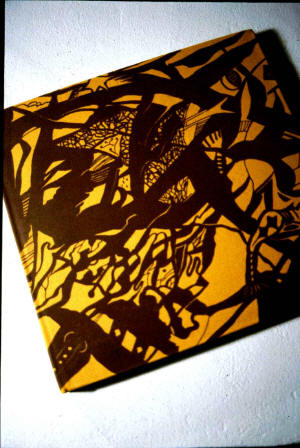 The method for converting the watercolors into
plates for the book, was to make the watercolor,
trace a portion of it, make a line cut from the
tracing, print the line cut onto linoleum blocks,
and cut the linoleum blocks for the color
blocks for the pages.
|
|
Watercolors in the first style, 1975. |

Easter at Gortys.
The plate in the book faithfully reproduces
the watercolor. |
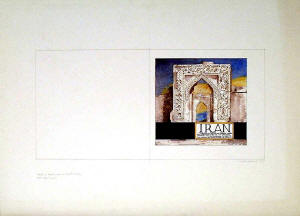
A title page for the section on Iran.
We used a different version,
made in the second style. |
|
Watercolors in the second style, 1976 |
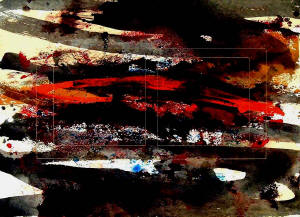
Afghanistan.
The grid represents a full size
double page spread
in the book. |
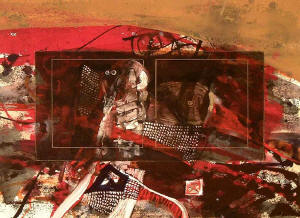
A nameless place in the Occident, or
"In the Deserts of the West."
Avicenna called it the place of war and ruin. |
|
Watercolors in the third style, that is, without
layout grid. |
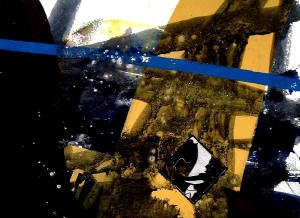
Iran, the Flight across the Mountains.
(private collection, Berkeley) |
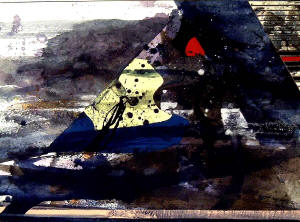
Seistan
Seistan is in the far east of Iran. In the book,
it's where you start to climb the mountains
of the east to come down into
the place of knowledge. |
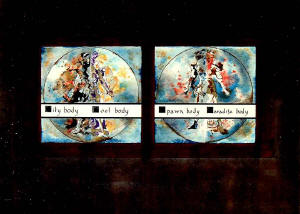
City body, Poet body, Spawn body,
Paradise body.
(private collection, El Cerrito, CA)
And in the place of knowledge you see
the true maps of the human body |
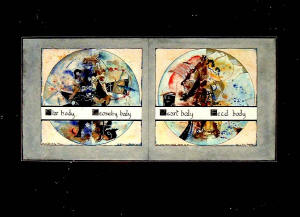
Star body, Geometry body, Heart body,
Seed body.
(private collection, El Cerrito, CA)
|
|
If there is a fourth style, "In the Earth" is it. |
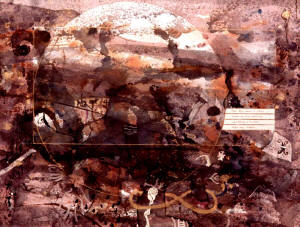
In the Earth
Near the end of the book the traveler goes to dwell
first in the earth, then in the sea, and then in the stars.
The text reads, "Their love gave a child, blooming
and seeding... before time began"

|
|